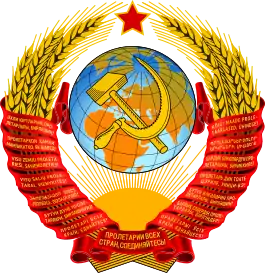State Council of the Soviet Union
Following the August 1991 Soviet coup d'état attempt, the State Council of the Union of Soviet Socialist Republics (USSR) (Russian: Государственный Совет СССР), but also known as the State Soviet, was formed on 5 September 1991 and was designed to be one of the most important government offices in Mikhail Gorbachev's Soviet Union. The members of the council consisted of the President of the Soviet Union, and highest officials (which typically was presidents of their republics) from the Soviet Union Republics. During the period of transition it was the highest organ of state power, having the power to elect a premier, or a person who would take Gorbachev's place if absent; the office of Vice President of the Soviet Union had been abolished following the failed August Coup that very same year.[1]
| Государственный Совет СССР | |
 | |
| Agency overview | |
|---|---|
| Formed | 5 September 1991 |
| Preceding agency |
|
| Dissolved | 26 December 1991 |
| Superseding agency |
|
| Jurisdiction | Union of Soviet Socialist Republics |
| Headquarters | Moscow, RSFSR, Soviet Union |
Inter-republican Economic Committee
With the central government's authority greatly weakened by the failed coup, Gorbachev[2] established a four-man committee, led by Russian SFSR Premier Ivan Silayev, that included Grigory Yavlinsky, Arkadi Volsky, and Yuri Luzhkov, to elect a new Cabinet of Ministers. This committee was later transformed into the Committee on the Operational Management of the Soviet Economy (COMSE), also chaired by Silayev, to manage the Soviet economy.[3] On 28 August 1991 Supreme Soviet a temporarily gave the COMSE the same authority as the Cabinet of Ministers,[4] and Silayev became the Soviet Union's de facto Premier.[5] COMSE was quickly surpassed in authority by the Inter-republican Economic Committee of the Soviet Union (IEC). Its function was to coordinate economic policy across the Soviet Union. As Chairman of both COMSE and the IEC, Silayev presided over a quickly disintegrating Soviet Union.[6]
When he first took office, Silayev wanted to reduce the powers of the central government and give more powers to the Soviet Republics. This view changed;[6] he demanded that Yeltsin give back much of the authority of the central government which he had usurped following the August Coup. In this he failed, and his position as Russian SFSR Premier was severely weakened as a result. Oleg Lobov, Silayev's First Deputy Premier, led the anti-Silayev faction in the Russian SFSR Council of Ministers and managed to oust him on 26 September 1991; Lobov succeeded Silayev as acting Premier of the Russian SFSR.[6] Silayev, as overseer of the economy, was given the task of initiating economic reforms in the Soviet Union in a way that suited both the central government and the Soviet republics.[7] Silayev tried to maintain an integrated economy while initiating the marketisation of the economy.[8] The IEC showed its international intent by signing the European Energy Charter on 16/17 December 1991 with 35 other countries, but this was undermined by the charter also being signed by nine of the twelve remaining republics.[9]
Dissolution of the Soviet Union
On 19 December COMSE was dissolved by a presidential Russian SFSR decree,[5] and Gorbachev resigned as Soviet President on 25 December. The next day, 26 December 1991, Silayev resigned from his post as IEC Chairman,[10] and the Soviet Union was formally dissolved by the Council of Republics.
References
- Government of the USSR: Gorbachev, Mikhail (5 September 1991). ЗАКОН СССР: Об органах государственной власти и управления Союза ССР в переходный период [Law: About state governing bodies of USSR in a transition period On the bodies of state authority and administration of the USSR in Transition] (in Russian). sssr.su. Retrieved 15 November 1991. Check date values in:
|access-date=(help) - Garcelon, Marc (2005). Revolutionary Passage: From Soviet to Post-Soviet Russia, 1985–2000. Philadelphia: Temple University Press. p. 167. ISBN 1-59213-362-2.
- Jeffries, Ian (1993). Socialist Economies and the Transition to the Market: A Guide. London; New York: Routledge. p. 100. ISBN 0-415-07580-7.
- Постановление Верховного Совета СССР от 28 августа 1991 г. № 2367-I «О недоверии Кабинету Министров СССР»
- Staff writer. "Silaev, Ivan Stepanovich" [Силаев, Иван Степанович]. praviteli.org. Archived from the original on 7 May 2011. Retrieved 4 April 2011.
- Shevchenko 2004, p. 66.
- Sakwa, Richard (2008). Russian Politics and Society. London; New York: Taylor & Francis. p. 33. ISBN 0-415-41527-6.
- Sakwa, Richard (2008). Russian Politics and Society. London;New York: Taylor & Francis. p. 228. ISBN 0-415-41527-6.
- Hansard 19 December 1991 c242W
- Staff writer. Силаев, Иван Степанович [Silayev, Ivan Stepanovich] (in Russian). warheroes.ru. Retrieved 4 April 2010.
| Political offices | ||
|---|---|---|
| Preceded by State Council (Russian Empire) |
State Council of the Soviet Union 5 September 1991-26 December 1991 |
Succeeded by State Council (Russia) |